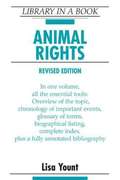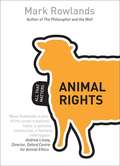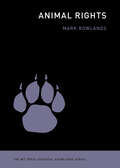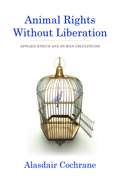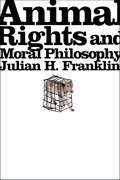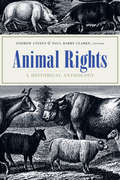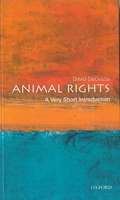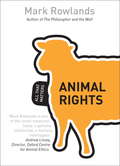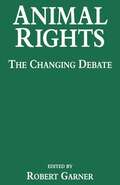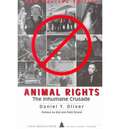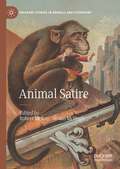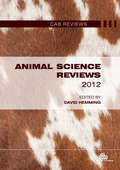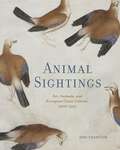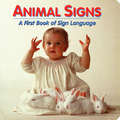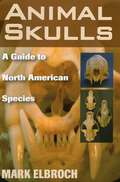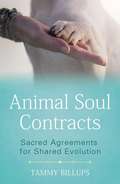- Table View
- List View
Animal Revolution
by Ron BroglioWhy our failure to consider the power of animals is to our deep detriment Animals are staging a revolution—they&’re just not telling us. From radioactive boar invading towns to jellyfish disarming battleships, this book threads together news accounts and more in a powerful and timely work of creative, speculative nonfiction that imagines a revolution stirring and asks how humans can be a part of it. If the coronavirus pandemic has taught us anything, it is that we should pay attention to how we bump up against animal worlds and how animals will push back. Animal Revolution is a passionate, provocative, cogent call for us to do so.Ron Broglio reveals how fur and claw and feather and fin are jamming the gears of our social machine. We can try to frame such disruptions as environmental intervention or through the lens of philosophy or biopolitics, but regardless the animals persist beyond our comprehension in reminding us that we too are part of an animal world. Animals see our technologies and machines as invasive beings and, in a nonlinguistic but nonetheless intensive mode of communicating with us, resist our attempts to control them and diminish their habitats. In doing so, they expose the environmental injustices and vulnerabilities in our systems. A witty, informative, and captivating work—at the juncture of posthumanism, animal studies, phenomenology, and environmental studies—Broglio reminds us of our inadequacy as humans, not our exceptionalism.
Animal Rhetoric and Natural Science in Eighteenth-Century Liberal Political Writing: Political Zoologies of the French Enlightenment (Routledge Studies in French and Francophone Literature)
by Andrew BillingOur tendency to read French Enlightenment political writing from a narrow disciplinary perspective has obscured the hybrid character of political philosophy, rhetoric, and natural science in the period. As Michèle Duchet and others have shown, French Enlightenment thinkers developed a philosophical anthropology to support new political norms and models. This book explores how five important eighteenth-century French political authors—Rousseau, Diderot, La Mettrie, Quesnay, and Rétif de La Bretonne—also constructed a "political zoology" in their philosophical and literary writings informed by animal references drawn from Enlightenment natural history, science, and physiology. Drawing on theoretical work by Derrida, Latour, de Fontenay, and others, it shows how these five authors signed on to the old rhetorical tradition of animal comparisons in political philosophy, which they renewed via the findings and speculations of contemporary science. Engaging with recent scholarship on Enlightenment political thought, it also explores the links between their political zoologies and their family resemblance as "liberal" political thinkers.
Animal Rights
by Lisa YountAfter summarizing the issues involved in animal welfare and rights and the applicable laws, the author provides a chronology of the movement, profiles of important figures, a glossary without pronunciation guides, advice on research, an annotated bibliography, a list of organizations and agencies, texts of bills and decisions, and tables and graphs. Annotation ©2004 Book News, Inc., Portland, OR (booknews.com)
Animal Rights
by Mark RowlandsAnimal Rights is a big deal. From animal testing to vegetarianism, and hunting to preservation of fish stocks, it's a topic that's always in the news. Mark Rowlands, author of The Philosopher and the Wolf, is the world's best known philosopher of animal rights. In this, the first introduction he has written to the topic, he starts by asking whether there is anything about humans that makes us psychologically or physiologically distinctive - so that there might be a moral justification for treating animals in a different way to how we treat humans. From this foundation, he goes on to explore specific issues of eating animals, experimentation, pets, hunting, zoos, predation and engineering animals. He ends with a challenging argument of how an improved understanding of animal ethics can and should affect readers' choices.
Animal Rights (The MIT Press Essential Knowledge series)
by Mark RowlandsA fresh view of animals and what we owe them.Do animals have moral standing? Do they count, morally speaking? In Animal Rights, Mark Rowlands argues that they do and explores the implications of this idea. He identifies three different waves in animal rights writing. The first wave was defined by a traditional dispute between utilitarianism (represented by Peter Singer) and rights-based approaches (represented by Tom Regan) to ethics. The second wave was defined by an expansion in a conception of ethics, which saw utilitarian and rights-based approaches supplemented by other ethical traditions, including contractualism, virtue ethics, and care ethics. The third wave was defined by an expansion in our conception of animals, driven by exciting new developments in the field of comparative psychology.Each of these waves had ramifications for how we understand the moral status of animals, but, this book argues, and reinforces, the core idea that animals deserve moral respect. In earlier waves, discussions of animal ethics had been focused on the issue of animal suffering. But the third wave is defined by the idea that animals are far more than merely sufferers or enjoyers of experiences but are instead authors of their own lives: creatures capable of choosing how to live, shaped by a conception of their life and how they would like it to go. Rowlands writes that, no matter what moral theory you choose, the most plausible version of that theory entails that animals have moral standing and that our obligations to them are far more substantial than many of us care to acknowledge.
Animal Rights And Human Morality (Third Edition)
by Bernard E. RollinIt's been more than two decades since the first edition of this landmark book garnered public accolades for its sensitive yet honest and forthright approach to the many disquieting questions surrounding the emotional debate over animal rights. Is moral concern something owed by human beings only to human beings? <p><p> Drawing upon his philosophical expertise, his extensive experience of working with animal issues all over the world, and his knowledge of biological science, Bernard E. Rollin -- now widely recognized as the father of veterinary ethics -- develops a compelling analysis of animal rights as it is emerging in society. The result is a sound basis for rational discussion and social policy development in this area of rapidly growing concern. He believes that society must elevate the moral status of animals and protect their rights as determined by their natures. His public speaking and published works have contributed to passage of major federal legislation designed to increase the well-being of laboratory animals. <p> This new third edition is greatly expanded and includes a new chapter on animal agriculture, plus additional discussions of animal law, companion animal issues, genetic engineering, animal pain, animal research, and many other topics.
Animal Rights Without Liberation: Applied Ethics and Human Obligations
by Alasdair CochraneThrough its emphasis on meeting learning objectives, the Task-Centered Model for Educational Supervision (TCS) accommodates new models of field instruction in social work, teaching accountability in fieldwork supervision and instructing novice social workers in how to be self-initiating and evaluative. The application of the TCS model in various real-life education and practice environments is illustrated by detailed case vignettes throughout the book.
Animal Rights Without Liberation: Applied Ethics and Human Obligations (Critical Perspectives on Animals: Theory, Culture, Science, and Law)
by Alasdair CochraneAlasdair Cochrane introduces an entirely new theory of animal rights grounded in their interests as sentient beings. He then applies this theory to different and underexplored policy areas, such as genetic engineering, pet-keeping, indigenous hunting, and religious slaughter. In contrast to other proponents of animal rights, Cochrane claims that because most sentient animals are not autonomous agents, they have no intrinsic interest in liberty. As such, he argues that our obligations to animals lie in ending practices that cause their suffering and death and do not require the liberation of animals. Cochrane's "interest-based rights approach" weighs the interests of animals to determine which is sufficient to impose strict duties on humans. In so doing, Cochrane acknowledges that sentient animals have a clear and discernable right not to be made to suffer and not to be killed, but he argues that they do not have a prima facie right to liberty. Because most animals possess no interest in leading freely chosen lives, humans have no moral obligation to liberate them. Moving beyond theory to the practical aspects of applied ethics, this pragmatic volume provides much-needed perspective on the realities and responsibilities of the human-animal relationship.
Animal Rights and Moral Philosophy
by Julian H. FranklinAnimals obviously cannot have a right of free speech or a right to vote because they lack the relevant capacities. But their right to life and to be free of exploitation is no less fundamental than the corresponding right of humans, writes Julian H. Franklin. This theoretically rigorous book will reassure the committed, help the uncertain to decide, and arm the polemicist.Franklin examines all the major arguments for animal rights proposed to date and extends the philosophy in new directions. <P><P>Animal Rights and Moral Philosophy begins by considering the utilitarian argument of equal respect for animals advocated by Peter Singer and, even more favorably, the rights approach that has been advanced by Tom Regan. Despite their merits, both are found wanting as theoretical foundations for animal rights. Franklin also examines the ecofeminist argument for an ethics of care and several rationalist arguments before concluding that Kant's categorical imperative can be expanded to form a basis for an ethical system that includes all sentient beings. Franklin also discusses compassion as applied to animals, encompassing Albert Schweitzer's ethics of reverence for life. He concludes his analysis by considering conflicts of rights between animals and humans.
Animal Rights: A Historical Anthology
by Linzey Andrew Paul Barry Clarke Eds.This comprehensive and diverse anthology, the only one of its kind, illuminates the complex evolution of moral thought regarding animals and includes writings from ancient Greece to the present. Animal Rights reveals the ways in which a variety of thinkers have addressed such issues as our ethical responsibilities for the welfare of animals, whether animals have rights, and what it means to be human.
Animal Rights: A Historical Anthology
by Linzey Andrew Paul Barry ClarkeIluminates the complex evolution of moral thought regarding animals
Animal Rights: A Reference Handbook
by Clifford J. SherryReviews the issues surrounding animal rights, including experimentation and animal harvesting. Presents the history of the issue, significant federal legislation, and arguments of activists on both sides of the debate. Includes biographical sketches and extensive annotated listings of organizations and print and nonprint resources.
Animal Rights: A Very Short Introduction
by David DegraziaThis volume provides a general overview of the basic ethical and philosophical issues of animal rights. It asks questions such as: Do animals have moral rights? If so, what does this mean? What sorts of mental lives do animals have, and how should we understand welfare? By presenting models for understanding animals' moral status and rights, and examining their mental lives and welfare, David DeGrazia explores the implications for how we should treat animals in connection with our diet, zoos, and research. Animal Rights distinguishes itself by combining intellectual rigor with accessibility, offering a distinct moral voice with a non-polemical tone.
Animal Rights: All That Matters
by Mark RowlandsAnimal Rights is a big deal. From animal testing to vegetarianism, and hunting to preservation of fish stocks, it's a topic that's always in the news. Mark Rowlands, author of The Philosopher and the Wolf, is the world's best known philosopher of animal rights. In this, the first introduction he has written to the topic, he starts by asking whether there is anything about humans that makes us psychologically or physiologically distinctive - so that there might be a moral justification for treating animals in a different way to how we treat humans. From this foundation, he goes on to explore specific issues of eating animals, experimentation, pets, hunting, zoos, predation and engineering animals. He ends with a challenging argument of how an improved understanding of animal ethics can and should affect readers' choices.
Animal Rights: All That Matters (All That Matters)
by Mark RowlandsAnimal Rights is a big deal. From animal testing to vegetarianism, and hunting to preservation of fish stocks, it's a topic that's always in the news. Mark Rowlands, author of The Philosopher and the Wolf, is the world's best known philosopher of animal rights. In this, the first introduction he has written to the topic, he starts by asking whether there is anything about humans that makes us psychologically or physiologically distinctive - so that there might be a moral justification for treating animals in a different way to how we treat humans. From this foundation, he goes on to explore specific issues of eating animals, experimentation, pets, hunting, zoos, predation and engineering animals. He ends with a challenging argument of how an improved understanding of animal ethics can and should affect readers' choices.
Animal Rights: Opposing Viewpoints
by Andrew HarnackEssays giving opposing viewpoints on a variety of topics related to animal rights. Areas include whether animals do in fact have rights, whether animal experimentation is justified, the use of animals for food and other commodities, the protection of wildlife, and unresolved issues within the animal rights movement.
Animal Rights: The Changing Debate
by Robert GarnerDo animals have rights and, if so, what exactly are they? Further, how do these rights relate to human rights? These questions have long bedeviled scientists, philosophers, and animal advocates and today remain as contested as ever. <p><p>Combining the writings of leading academics and activists such as Peter Singer and Michael W. Fox, this anthology examines the development of animal rights discourse over the past quarter century to anticipate the future of the debate. Touching on every aspect of human-animal relations, from agriculture and animal experimentation to the animal rights movement in the United States and abroad, the contributors both question and affirm the utility of the concept of rights. <p><p>Informing this volume is the belief that, regardless of where one stands on the issues of animal rights, it is simply indisputable that how we perceive and treat animals is fundamentally and inextricably related to how we define ourselves.
Animal Rights: the Inhumane Crusade
by Daniel T. OliverA thorough-going discussion and analysis of the animal rights movement, including history, philosophy and tactics. Contains dosiers of prominant figures as well as organizations. Chapter footnotes and bibliography are also included.
Animal Satire (Palgrave Studies in Animals and Literature)
by Susan McHugh Robert McKayAnimal Satire presents a cultural history of animal satire, a critically neglected but persistent presence in the history of cultural production, in which animals expose human folly while the strategies of satire expose the folly of human-animal relations. Highlighting the teeming animal presences across the history of satirical expression from Aristophanes to Twitter, with chapters on key works of literature, drama, film, and a plethora of satirical media, Animal Satire reveals the rich rhetorical significance of animality in powering the politics of satire from ancient and medieval through modern and contemporary times. More pressingly, the book makes the case for the significance of satire for understanding the real-world implications of rhetoric about animals in ongoing struggles for justice. By gathering both critical and creative examples from representative media forms, historical periods, and continents, this volume aims to enrich scholarship on the history of satire as well as empower creative practitioners with ideas about its practical applications today.
Animal Science Reviews 2012
by David HemmingAnimal Science Reviews 2012 provides scientists and students with analysis of key topics in current research including breeding, animal behaviour, zoonotic diseases and environment. Experts such as Mike Stear, James France, Phillip Klesius and Frederick Silversides give essential overviews of their fields. Originally published online in CAB Reviews, this volume makes available in printed form the reviews in animal science published during 2012.
Animal Sightings: Art, Animals, and European Court Culture, 1400–1550
by Jodi CranstonAnimal Sightings challenges two common ideas about the depiction of animals in early modern European court art: first, that the human figure relegated animals to peripheral and often symbolic roles, both compositionally and conceptually, and second, that the representation of animals during this period was predominantly tied to a growing interest in naturalism derived from scientific study and discovery. Art historian Jodi Cranston considers the diversity of art representing animals common to that time and place, including dogs, stags, falcons, and even insects. She discusses how early modern European courts (primarily in northern Italy, Tyrol, Saxony, and southern Germany, where the preponderance of European courtly activity related to animals occurred) acquired and kept living animals, sponsored hunts in purpose-cultivated forests, and fostered trade in animal products. The diverse works created by artists associated with those courts reveal an ambivalent and complex view of animals as beings who shared and shaped the world alongside humans. Ultimately, Animal Sightings explores how early modern artists and viewers thought about human-animal interactions, how visual representation facilitated and inhibited knowledge about animals, and how animals could reveal the limits and possibilities of visual representation. It should be of special interest to scholars of early modern studies, art history, and animal studies.
Animal Signs: Animal Signs
by Debbie SlierCharming, full-color photographs of basic animals plus illustrations of their corresponding signs offer children ages 1 to 4 a fun way to learn their first signs and vocabulary words. Constructed of sturdy cardboard with a protective finish on each page, this hearty book will withstand the hard use to which fascinated young children will subject it, reading it again and again. Studies have shown that babies who learn to sign can communicate at an earlier age than those who learn verbal communication alone. Other research indicates that children strengthen their grammar and vocabulary skills by learning sign language. Animal Signs and its companion book, Word Signs, offer children exciting new worlds describing favorite things and animals while also making learning language skills fun!
Animal Skulls
by Mark ElbrochComprehensive guide to the animals of North America. Fully illustrated with drawings and photographs. User-friendly format makes comparing species easy.
Animal Soul Contracts: Sacred Agreements for Shared Evolution
by Tammy BillupsA guide to discovering the spiritual agreements between our souls and those of our animal companions • Explains how animals have physical or behavioral issues to evolve their souls as well as help our soul&’s evolution and release past-life karma • Describes what happens energetically and spiritually with animals in the weeks before they transition and during their passing • Includes practical instructions for identifying the different types of animal soul contracts and aligning with them to assist your shared evolutionary journey Animal lovers are extraordinary. Despite awareness that we will probably outlive our beloved pets, we are still drawn, time and time again, to the connection, joy, and unconditional love that come with sharing our lives, homes, and laps with animals. Many of us feel something deeper than just companionship with our animal friends--a heart-to-heart connection felt all the way to the soul level. Revealing the higher purpose and soul mission behind our relationships with our animal companions, Tammy Billups explores the spiritual contracts that are created when a human bonds with an animal and shows how we come into each other&’s lives for a reason. Providing real-life examples, Billups explains why animals choose, at the soul level, to have certain perceived negative experiences, such as physical or behavioral issues, to evolve their souls, clear karma, and help our soul&’s evolution. She shows that human and animal souls orchestrate every experience and interaction that holds potential for transformation and healing, including the final transition. She demonstrates the inner dynamics of the animal-human relationship to help animal lovers understand their soul contracts with their pets. The inspirational, real-life examples of animal-human tandem healings that Billups facilitated identify the soul contracts within each pairing that transformed feelings of grief, loss, abandonment, betrayal, trauma, abuse, and anxiety. The author reveals how animals we have previously loved and shared our lives with come back, either on the spirit level or reincarnated in a new animal form, to support us. Offering peace and hope to those who&’ve lost beloved animal companions, she describes what she&’s witnessed during healing sessions with animals in the weeks before they transition and during their passing. Billups also includes practical instructions for identifying different types of animal soul contracts and connecting with and enlisting the help of your light team or spirit guides. By discovering the soul agreements that underlie our animal partnerships, we can find meaning in the issues that arise with our animals and ourselves, support our souls&’ mutual evolution, and allow the soul contracts to weave their spiritual magic in the animal-human relationship.
Animal Sounds (A Golden Sturdy Book)
by Aurelius Battaglia Golden BooksWhat does the crow say? Caw! Caw! The donkey says hee-haw, hee-haw! The cow says moo-o-o-o-o! What do the owls say? Whoo-o-o-o-o! Children will love imitating the sounds each of the animals, birds, and insects make in this colorfully illustrated sturdy board book.


